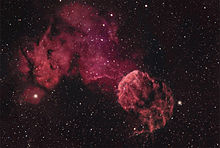Usuario:Mauryfrapi/Taller de Edición1
| Sh2-248 | |||||
|---|---|---|---|---|---|
 Sh2-248 | |||||
| Tipo | [[]] | ||||
| Ascensión recta | 0 h 0 m 0 s | ||||
| Declinación | +0°0′0″ | ||||
| Distancia | KAl | ||||
| Tamaño aparente (V) | × minutos de arco | ||||
| Constelación | [[]] | ||||
| Características físicas | |||||
| Radio | Al | ||||
| Otras designaciones | SNR G189.0+03.0, IC 443 | ||||
| Sucesión de nebulosas | |||||
| |||||



http://apod.nasa.gov/apod/ap030903.html 2003 September 3 Galactic Supernova Remnant IC 443 Credit & Copyright: Jean-Charles Cuillandre (CFHT), Hawaiian Starlight, CFHT Authors & editors: Robert Nemiroff (MTU) & Jerry Bonnell (USRA) NASA Web Site Statements, Warnings, and Disclaimers NASA Official: Jay Norris. Specific rights apply. A service of: LHEA at NASA / GSFC & Michigan Tech. U.
Explanation: About 8000 years ago, a star in our Galaxy exploded. Ancient humans might have noticed the supernova as a temporary star, but modern humans can see the expanding shell of gas even today. Pictured above, part of the shell of IC 443 is seen to be composed of complex filaments, some of which are impacting an existing molecular cloud. Here emission from shock-excited molecular hydrogen is allowing astronomers to study how fast moving supernova gas affects star formation in the cloud. Additionally, astronomers theorize that the impact accelerates some particles to velocities near the speed of light. Supernova remnant IC 443 is also known to shine brightly also in infrared and X-ray light.